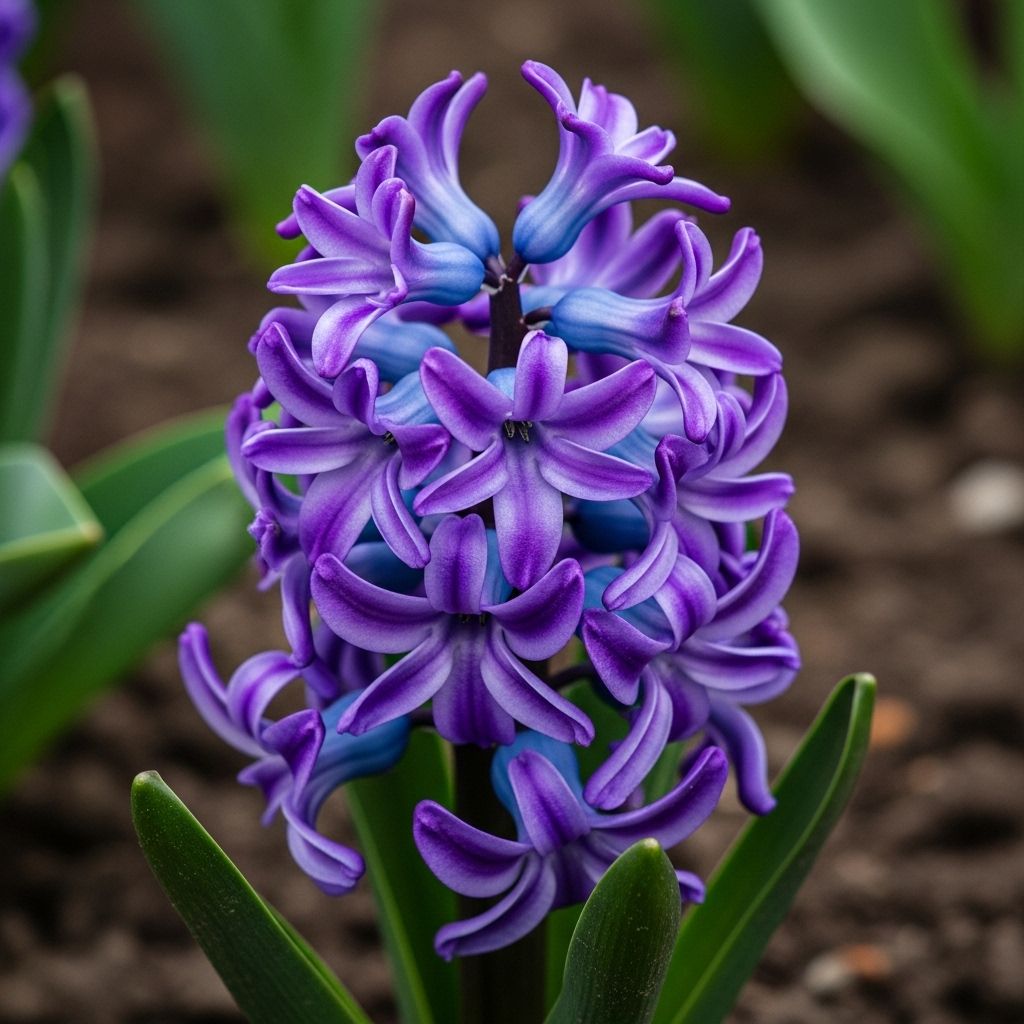Are Hyacinths Annual or Perennial? Understanding Their Life Cycle and Care
Chill needs and proper planting help bulbs rebloom with vibrant, fragrant spring flowers.

Image: HearthJunction Design Team
Are Hyacinths Annual, Biennial, or Perennial Plants?
Hyacinths are a beloved spring flower, renowned for their striking clusters of vibrant blooms and a fragrance that can fill a garden with perfume. However, gardeners often wonder: are hyacinths annuals, biennials, or perennials? Understanding the life span and care requirements of hyacinths is crucial for anyone seeking to cultivate these bulbs for seasons of enjoyment.
The Short Answer: Hyacinths Are Perennial Bulbs
Hyacinths are perennial. Once established in the right environment, they return each spring, bringing fresh color and scent to your garden for years to come. Still, climate, care, and garden zone can strongly affect their longevity and whether they thrive as true perennials or behave more like annuals in some regions .
Hyacinths at a Glance
- Type: Perennial spring-flowering bulbs
- USDA Hardiness Zones: 3–8 (ideal longevity in cooler zones)
- Bloom Time: Early to mid-spring
- Flower Colors: Pink, purple, white, blue, yellow, and more
- Height: Generally 6–12 inches
- Preferred Light: Full to partial sun
Life Cycle of the Hyacinth
To understand whether hyacinths will return every year, it helps to look at their botanical classification and life cycle.
- Biennials complete their life cycle in two years — typically growing foliage the first year, flowering and producing seed the second, then dying.
- Hyacinths, however, are perennials: after planting, these bulbs produce lush blooms in the first spring and, if cultivated properly, re-flower for several years afterward.
While hyacinths are perennials by definition and will rebloom each year under the right conditions, their best performance is usually in the first few seasons after planting. Over time, the vigor of the blooms may wane, leading some gardeners to replant for consistently impressive displays .
When to Treat Hyacinths as Annuals vs. Perennials
The treatment of hyacinths as annuals or perennials is determined by local climate, soil, and cultural preferences:
- In cool climates (zones 4–6): Hyacinth bulbs reliably come back for several years, especially if given winter chill. The bulbs naturalize and form small clumps, though the blooms may diminish in size and quantity after 3–4 years.
- In mild to warm climates (zones 7–8): Without enough winter chilling, bulbs don’t always flower as vigorously. Gardeners often dig bulbs up after flowering, chill them artificially, or replant fresh each autumn, treating them more like annuals.
- In hot climates (zones 9+): Hyacinths struggle due to insufficient cold. Most gardeners treat them strictly as annuals, discarding bulbs after bloom.
Why Blooms Diminish Overtime
Hyacinths multiply slowly by forming offsets—mini bulbs that eventually produce new flowers. Over several years, the original bulb’s vigor declines, and the clump may become crowded. This leads to smaller and less impressive flowers. For this reason, some gardeners refresh their hyacinth displays by replanting new bulbs regularly.
How to Grow Hyacinths Successfully
With their ease of growth and minimal maintenance requirements, hyacinths are a perfect choice for both beginner and experienced gardeners. Here’s how to keep your bulbs healthy and productive over multiple seasons:
Choosing the Right Location
- Sun exposure: At least 4 hours of direct sun per day. Partial shade is tolerated but may reduce flower quality.
- Soil: Well-draining, fertile soil is essential — hyacinths are prone to rot if left in soggy ground.
- Protection: Shelter from strong winds helps preserve the upright spikes of flowers.
When and How to Plant Hyacinth Bulbs
- Planting Time: Plant in autumn, several weeks before the ground freezes. This gives bulbs time to establish roots before winter dormancy.
- Planting Depth: 4–6 inches deep, depending on your climate — 6 inches in colder areas for frost protection, 4–5 inches elsewhere .
- Spacing: 4–6 inches apart to allow for air circulation and future spread.
- Pointy Side Up: Always plant bulbs with the pointed end (growing tip) facing upwards.
Hyacinth bulbs are large and easy to handle. Use gloves when planting, as the bulbs contain oxalic acid, which can irritate skin.
Watering & Mulching
- Water newly planted bulbs thoroughly, then allow the bed to dry out. Hyacinths need little supplemental water once established except in the case of spring droughts.
- Apply 1–2 inches of mulch once the soil has cooled to protect bulbs through winter and suppress weeds come spring .
Temperature & Winter Requirements
Cold is crucial: For perennial re-blooming, hyacinths need a winter chill period of at least 12–14 weeks under 50°F (10°C). Without it, flower formation for the following spring is poor or absent .
This is why hyacinths perform so well in regions with frosty winters — the natural chilling period primes dormant bulbs for robust blooming.
Climate Adaptation: Perennial vs. Annual Care by Zone
| USDA Zone | Hyacinth Behavior | Best Practice |
|---|---|---|
| 3-6 | Perennial | Plant in ground, allow to naturalize |
| 7-8 | Short-lived perennial / often annual | Dig and chill or replant each fall |
| 9+ | Annual | Treat as annual, discard after bloom |
Hyacinths Indoors: Forcing Bulbs Out of Season
Hyacinths can easily be forced to bloom indoors, a practice especially popular in winter. To do this:
- Chill bulbs in a refrigerator or unheated garage for 10–12 weeks before placing them in pots.
- After chilling, plant bulbs in containers with the tips just exposed, water well, and place in a bright, cool location.
- Enjoy blooms indoors in late winter or early spring — a treat for senses during gray months!
Common Hyacinth Care Questions & Concerns
- How long do hyacinths last? — In the garden, expect 3–5 years of repeat blooming if bulbs receive proper chill and are not crowded or diseased. Indoors, forced bulbs usually have one spectacular season.
- Why are my hyacinths not blooming as well this year? — Likely causes include insufficient chilling, overly wet or compacted soil, or overcrowding. Consider lifting, dividing, and replanting bulbs or refreshing with new stock.
- Should I remove spent blooms? — Yes, deadheading prevents seed set and encourages bulbs to channel energy back to storage for next year’s flowers.
Tips for Maximizing Hyacinth Longevity
- Leave foliage until fully yellowed: The leaves gather sunlight, storing energy in the bulb for next spring’s blooms. Only remove when they pull away easily.
- Feed after flowering: A balanced bulb fertilizer or compost boosts energy reserves for next season.
- Avoid wet feet: Ensure bed drainage remains good year-round to prevent bulb rot.
- Divide clumps: Every 3–4 years, lift bulbs in late summer, separate offsets, and replant for better displays.
Varieties and Companion Planting
Hyacinths come in a kaleidoscope of colors, from lilac blues to hot pinks and creamy whites. Mix different cultivars for “rainbow” beds, or pair with tulips and daffodils for classic spring combinations. Container displays are another excellent option, especially for urban or balcony gardeners.
Hyacinth Growing Checklist
- Choose a sunny, well-drained spot
- Plant bulbs in fall, 4–6 inches deep and apart
- Water well at planting, then sparingly
- Mulch for winter protection
- Deadhead after flowering and leave the foliage until it fades
- Lift, divide, and replant every few years for vigor
Frequently Asked Questions (FAQs)
Q: Are hyacinths safe for pets and children?
A: Hyacinth bulbs contain compounds that can cause stomach upset, irritation, or allergic reactions if ingested. Always plant bulbs deeply and supervise pets and children in garden areas where hyacinths are grown.
Q: Can I leave hyacinth bulbs in the ground after blooming?
A: Yes, in zones 4–8, hyacinths usually overwinter well if planted deep enough and mulched. In hot or wet climates, dig and store bulbs until fall.
Q: How can I get bigger blooms year after year?
A: Fertilize after flowering, avoid removing leaves until yellowed, improve drainage, and divide overcrowded clumps every few years.
Q: Are hyacinths easy to force indoors?
A: Yes! Chill bulbs for 10–12 weeks, pot up, and keep in a cool, sunny spot for fantastic late winter color indoors.
Q: Why might my hyacinths disappear after a few years?
A: Diminished blooms and eventual disappearance are common in areas without winter chill, poor drainage, or if bulbs are not lifted and divided every few years.
Conclusion
Hyacinths are botanically perennials, returning year after year when given sufficient winter chill and basic care. Their spectacular blooms and scent make them a must-have for spring gardens. While some treat them as annuals for maximum visual impact, proper planting and occasional dividing will let many gardeners enjoy reliable hyacinth displays for years. Whether you garden in a cool temperate zone or force bulbs for indoor cheer, hyacinths are a classic, rewarding bulb to grow.
References
Read full bio of Anjali Sayee












